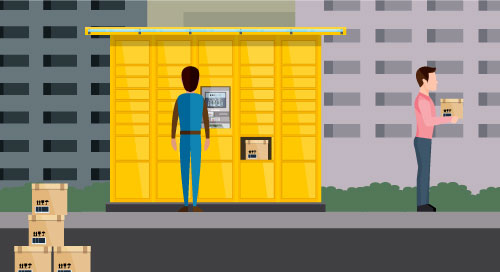AI Building Blocks for a Self-Service Kiosk

For businesses to accommodate shifts in customer preferences, many will need solutions that use artificial intelligence (AI), computer vision, and deep learning. The challenge for some developers? The process is too long and complex, while for others the obstacle is creating such a solution without having years of AI development experience.
These problems can be solved by using existing API libraries, machine learning algorithms, and other software that speeds time to market and simplifies the development of high-performance AI solutions. For example, by piggybacking on existing work, it took meldCX, an enterprise platform developer, just eight weeks to build a self-service kiosk proof of concept (POC) for the Australia Post.
Streamlining the Self-Service Process
Australia Post recognized that shipping parcels produced far more profit than mailing letters, but their customers had issues with the shipping process. Specifically, the wait times for packages getting weighed, insured, and sent on their way hindered the customer experience. That led to the need for a self-service option that streamlined the process.
With that in mind, Australia Post asked meldCX to develop a solution that would allow customers to handle the following tasks in 120 seconds or less:
- Scan and detect parcel type and information
- Automatically measure the size and weight of the package
- Read handwritten information and convert it into shipping data
- Verify the sender's identity, the recipient’s address, and shipping cost
Australia Post also specified several other requirements. For example, reducing manual data entry frees up staff to work on more productive activities—something nearly all retailers want.
In addition, the development team needed to include other common functionalities that are standard on a variety of computer vision projects. Developers can now take meldCX’s work—lock, stock, and barrel—and apply it to their own solutions. That includes capabilities like:
- Ensuring clean data entry on the front end to avoid data accuracy issues on the back end
- Speeding up business processes
- Reducing friction and providing more value for all stakeholders
Building Upon Previous AI Solutions
Fundamental to the rapid development model—used to create the Smart Parcel Kiosk—is building upon the extensive work meldCX performed on previous AI solutions for retail businesses as well as readily available technology. This included handwriting recognition algorithms and data handling models, in addition to meldCX business rules. AI developers can take advantage of this work by using it in their own projects.
This technology can be used in new configurations to solve different use cases and challenges across a wide range of sectors. In doing so, it helps others to radically cut development time.
“What's really changed from our last project,” says meldCX CEO Stephen Borg, “was the opportunity to gather all the information we learned and apply it to this one. That lets us go from inception to delivery in about eight weeks, while our previous AI project took more than a year.”
In addition to reusing algorithms, the development team plugged in numerous pieces of familiar AI technology, including Intel® RealSense™ cameras, the Intel® OpenVINO™ toolkit, and the Intel® Movidius™ Neural Compute Stick.
“OpenVINO at the edge helps us optimize the model with the hardware resources available,” says Borg. “And we're offloading certain models that can slow down the user experience to Movidius.”
OpenVINO at the edge helps us optimize the model with the hardware resources available. And we're offloading certain models that can slow down the user experience to Movidius.” —Stephen Borg, meldCX
Training for Accuracy
The meldCX team discovered that the solution doesn’t need to capture at the edge an entire address using Google’s handwriting detection and recognition API. Instead, it could use parts of the address as identifiers, which an Intel®machine learning model could assign a confidence level to complete. These parts included addresses, box numbers, street names, cities, towns, states, territories, and postal codes. When the solution returned multiple potential addresses, it simply asked customers to select the one they wanted.
Another thing the team realized is that addresses contained in databases such as Google Maps don’t always function as mail delivery addresses. This meant they could not rely on Google alone to handle this part of the process, as some other postal kiosk solutions have tried.
The meldCX solution used the Australia Post Address API to validate addresses and helped the postal service improve the accuracy of its database by tracking packages from the creation of the shipping label to delivery. This allowed the postal service to further verify its address system and to make corrections. That often came into play when cities use similar street names, such as Talbot Road and Talbot Terrace, especially when within the same postal code.
Developers working on different use cases will likely uncover their own anomalies and neural networks. And train their data models to make corrections.
Rapid Retail Analytics Development Keeps Up with Changes
The retail industry sees computer vision as an essential technology, allowing businesses to offer better customer experiences while lowering costs and increasing efficiency. Taking advantage of meldCX building blocks and streamlined models enables developers to build solutions in less time—providing exciting new business opportunities.
This article was edited by Christina Cardoza, Associate Editorial Director for insight.tech.
This article was originally published on February 3rd, 2020.